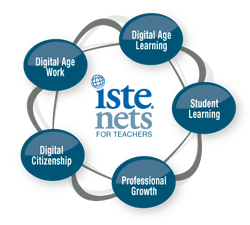1. Facilitate and Inspire Student Learning and Creativity

Teachers use their knowledge of subject matter, teaching and learning, and technology to facilitate experiences that advance student learning, creativity, and innovation in both face-to-face and virtual environments.
a. Promote, support, and model creative and innovative thinking and inventiveness
b. Engage students in exploring real-world issues and solving authentic problems using digital tools and resources
c. Promote student reflection using collaborative tools to reveal and clarify students’ conceptual understanding and thinking, planning, and creative processes
d. Model collaborative knowledge construction by engaging in learning with students, colleagues, and others in face-to-face and virtual environments
a. Promote, support, and model creative and innovative thinking and inventiveness
b. Engage students in exploring real-world issues and solving authentic problems using digital tools and resources
c. Promote student reflection using collaborative tools to reveal and clarify students’ conceptual understanding and thinking, planning, and creative processes
d. Model collaborative knowledge construction by engaging in learning with students, colleagues, and others in face-to-face and virtual environments
Artifact 1: Digital storytelling through pictures: The Hunger Games
|
|
This digital story telling project was a collaborative effort, with my contributions being three of the pictures and the copy, which was voiced by another student. The intended purpose was to create a mock promotional/public service announcement for the different districts found in The Hunger Games. I think this piece is a great representation of how to incorporate a variety of technological media (digital pictures and audio to create a video) to produce a creative end product. Digital story telling has very wide applications in the classroom, and can be used in almost every grade level and/or subject.
|
Artifact 2: Multimedia e-book
|
|
Please note that this e-book may take a while to load depending on internet connection speeds.
For this project I created an e-book using images, text, and audio to humorously teach the concept of idioms. The intended audience for this e-book was students at my school who are deaf and/or hard of hearing, as they sometimes have difficulty with this topic. This project greatly stretched my skill in terms of the abilities of PowerPoint, especially adding motion to objects and manipulating/creating/grouping objects and images. While there are other platforms for creating e-books (the software Storybook Weaver, for example), PowerPoint is ubiquitous and students are often well-acquainted with it. As with digital storytelling, creating e-books can be adapted to almost every grade level and/or subject. |
Reflections
I enjoyed all of my projects in my classes, but those that allowed me to use technology creatively were by far my favorite. While the coming of web 2.0 encourages more creation of content, there is still the stereotype that technology/computers and creativity do not mix, and those who are technically minded cannot be creative, and vice versa. Furthermore, students should not just be passive consumers of technology, but creators who apply higher level thinking skills.
I believe that both of my artifacts support ISTE’s student learning standard. Both the digital storytelling and e-book are creative products that pull in a variety of multimedia. For my e-book, I was able to use some standard features (object motion, grouping and ungrouping objects) in a fairly innovative way to bring a sense of comic animation that would appeal to children. Furthermore, students who are deaf and/or hard of hearing often have difficulties with the intricacies and subtleties of language, so students could help solve an authentic problem by collecting their own idioms and creating an e-book that is meaningful to them. For the digital storytelling, I collaborated with my fellow students to create something in a virtual space.
I believe that both of my artifacts support ISTE’s student learning standard. Both the digital storytelling and e-book are creative products that pull in a variety of multimedia. For my e-book, I was able to use some standard features (object motion, grouping and ungrouping objects) in a fairly innovative way to bring a sense of comic animation that would appeal to children. Furthermore, students who are deaf and/or hard of hearing often have difficulties with the intricacies and subtleties of language, so students could help solve an authentic problem by collecting their own idioms and creating an e-book that is meaningful to them. For the digital storytelling, I collaborated with my fellow students to create something in a virtual space.
